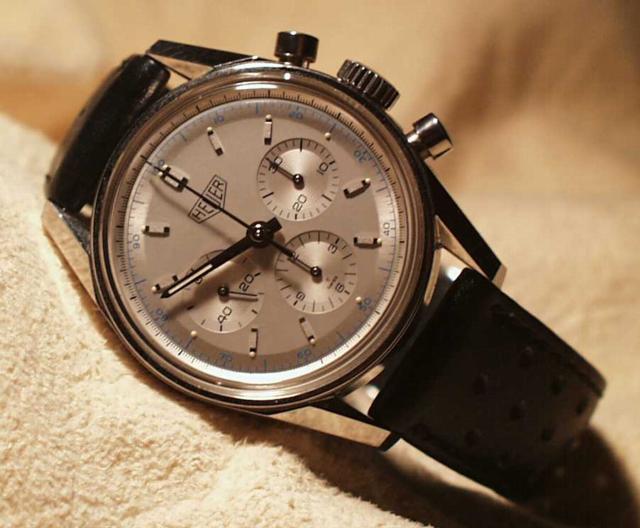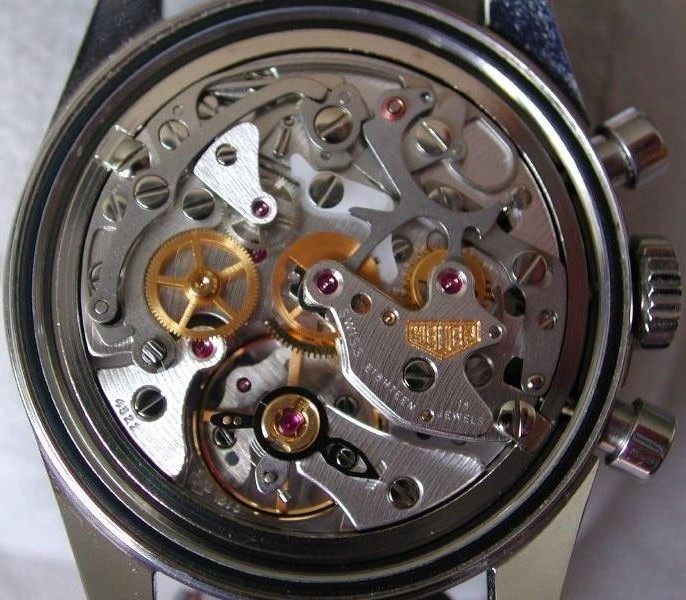 Heuer Carrera Chronographs:
Heuer Carrera Chronographs:
 - A
Brief Overview: Then, Now and the
Future:
|
- A
collaboration between
- Matthias
Liebe-Kleymann
 & Chuck
Maddox
& Chuck
Maddox

- Based on
a thread from 19 June
2002,
- Last
Revised: 18 May 2003, 11:12
GMT.
- Certain
Rights Reserved.
|
- Top,
In
The
Beginning,
- The
1960s,
The
1970s,
- The
1980s,
The
1990s,
- Now
and the future...
- Addendum,
Author's
Notes,
- Certain
Rights Reserved
|
- Click
here to go to Part 4: The
1980's
-
-
-
|
|
The story could well
have ended then and there. Under new management,
Heuer was recast as TAG-Heuer. Old lines were
dropped, new ones created. TAG-Heuer
transitioned from a largely "Tool-Watch"
manufacturer specializing in Chronographs,
Stopwatches and sporting events timing, to a
luxury watch manufacturer with an emphasis on
"avanté garde" design. Hence the name
"Techniqués d'Avanté
Garde".
While the new product
line achieved great financial success, it came
with a cost. Many people who remembered and
valued "the old Heuer" were not so keen on the
direction that the new management were set on.
For many years there was not a Carrera model, as
the often plain, austere and older styling did
not mesh well with the bold styling of the lines
added after the TAG takeover like the S/EL and
6000. The Carrera line was largely forgotten
except by those who had owned one, or perhaps
wished they could find one to purchase.
Eventually, towards 1997/1998, TAG-Heuer finally
realized that the roots of the brand was still
cherished and had retained great salability and
launched a "Classics" series of watches. The
first "new-old" model was the 1964 Carrera
Re-Edition.

|
|
--
Chuck's 1964 Re-Edition Carrera
Silver Dial. Note the lack of
"Carrera" on the dial and the
Silver not white color of the
dial
|
- At first three new
Carrera "Re-Editions were offered for sale to
the public in a case and style nearly
identical to the original 1964 model, which
is now widely considered a classic by most
collectors:
- In 18k Yellow
Gold
- In Stainless Steel
with a Silver Dial
- In Stainless Steel
with a Black Dial
-
- For the most part
the Re-Edition models are a fairly close
approximation of the 1964 Heuer Carrera as
shown in the catalog near the beginning of
this article. Internally, the original models
were powered by a Valjoux c.72 movement. A
venerable and very popular column-wheel
mechanical movement used by nearly every
major watch manufacturer at one time or
another including Rolex, with the only
exception seeming to be Omega and Tissot. The
Valjoux 72 was the counterpart and main
competitor/rival of the Lemaina movement used
in the Speedmasters of the same epoch known
to most Omega owners/collectors as the c.321
movement. Valjoux ceased production of the
c.72 movement at some point in the 1970's to
concentrate on production of the 7750 family
of movements which it considered to be the
next big then. They seem to have been proven
correct on that one.
-
- So when TAG-Heuer
sought to re-release a version of the 1964
model, they ironically choose the movement
that replaced the original movement's main
competitor, the Lemania c.1873, known to most
Omega fans as the c.1861 movement which power
the current Omega Speedmaster Professional
Moonwatch. The level of finish on the
movements of the Re-Edition Carrera and the
Moonwatch are comparable, nearly
identical.
-
 -
- So once again anyone
could visit their local TAG-Heuer Dealer and
purchase a "Heuer Carrera" to wear while
driving a vintage car through Mexico... The
Carrera Panamercana rallye is once again
alive since it's revival in the late
1980's.
-
- So how did the
Classics line fair? The Carrera Re-Editions
(along with their Monaco Re-Edition line
mates) were tremendous sales and critical
successes, and TAG-Heuer quickly added
additional models to each classic product
line. First were two new variants of the
existing Chronograph line with "Daytona
Rings" added to the sub-dials of a new Black
and Copper dial version:
-
|
|
These models are
identical to the previous Stainless Steel cased
models with the exception of the dial and model
number. The movement remains the Lemania 1873
used previously.
In addition to these two
chronograph models, TAG-Heuer choose to add two
models (with attendant dial/strap variations to
complement the chronograph models...
These new models are
"Classics" in name and styling only. There are
no direct or indirect relation to any models
that Heuer produced in the 1960's or 1970's...
At the time Heuer concentrated entirely on
Chronographs, stopwatches and sporting event
timing. These new models sported fairly
commonplace ETA movements in Carrera cases with
newly designed dials for the Classics
line.

|
|
--
Photo provided by Jorge
Merino
|
|
|
|
- Click
here to go to Part 6: Now and the
Future
|
|
|
Permission for
personal, educational or non-commercial use is
granted as long as this notice and the document
remains intact and unaltered. The authors retain
all other rights not specifically mentioned
here... For all other use please contact the
authors.
Disclaimer: Opinions are
our own and knowing us should be taken with a grain
or two of salt...
|
|
|
|